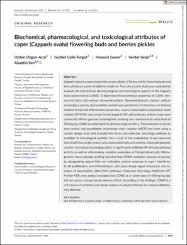| dc.contributor.author | Ozgun-Acar, Ozden | |
| dc.contributor.author | Celik-Turgut, Gurbet | |
| dc.contributor.author | Guner, Huseyin | |
| dc.contributor.author | Sezer, Serdar | |
| dc.contributor.author | Sen, Alaattin | |
| dc.date.accessioned | 2023-02-24T08:12:14Z | |
| dc.date.available | 2023-02-24T08:12:14Z | |
| dc.date.issued | 2022 | en_US |
| dc.identifier.issn | 2048-7177 | |
| dc.identifier.other | WOS:000832852100001 | |
| dc.identifier.uri | https://doi.org/10.1002/fsn3.3012 | |
| dc.identifier.uri | https://hdl.handle.net/20.500.12573/1455 | |
| dc.description.abstract | Capparis ovata is a natural plant that grows widely in Turkey and its flowering buds and
berry pickle are used in traditional medicine. Thus, the current study was expanded to
evaluate the biochemical, pharmacological, and toxicological aspects of the Capparis
ovata water extract (COWE). To determine the biochemical properties of COWE, mineral and fatty acid content, elemental analysis, flavonoid/phenolic content, radicalscavenging capacity, and pesticide analysis were performed. Furthermore, to find out
whether it had anti-inflammatory properties, reverse transcription-polymerase chain
reaction (RT-PCR) and nuclear factor kappa B (NF-κB) luciferase activity tests were
conducted. Whole-genome transcriptomic profiling was carried out at a dose level of
500 mg/kg COWE to understand its pharmacological effect. Transaminases in serum
were tested, and quantitative polymerase chain reaction (qPCR) was done using a
custom design array that included the stress and molecular toxicology pathway to
establish its toxicological qualities. As a result of the evaluations, it was observed
that COWE has a high mineral and unsaturated fatty acid content, flavonoid/phenolic
content, and radical-scavenging ability. It significantly inhibited NF-κB transcriptional
activity as well as inflammatory cytokine expression in T-lymphoblast cells. Wholegenome transcriptomic profiling depicted that COWE modulates immune responses
by upregulating natural killer cell activation, cellular response to type I interferon,
B-cell proliferation and differentiation, and Janus kinase–signal transducer and activator of transcription (JAK–STAT) pathways. Molecular Toxicology Pathfinder RT2
Profiler PCR array analysis revealed that COWE at or lower dose of 500 mg/kg/day
did not cause a comparatively adverse effect. According to the findings, COWE is a
rich source of nutrients and can be used as an adjunct therapy for various inflammatory diseases | en_US |
| dc.description.sponsorship | The Scientific and Technological Research
Council of Turkey, Grant/Award Number:
112S117 and 109H002 | en_US |
| dc.language.iso | eng | en_US |
| dc.publisher | WILEY | en_US |
| dc.relation.isversionof | 10.1002/fsn3.3012 | en_US |
| dc.rights | info:eu-repo/semantics/openAccess | en_US |
| dc.subject | anti-inflammatory | en_US |
| dc.subject | Capparis ovata | en_US |
| dc.subject | complementary | en_US |
| dc.subject | toxicology | en_US |
| dc.subject | whole-genome transcriptome | en_US |
| dc.title | Biochemical, pharmacological, and toxicological attributes of caper (Capparis ovata) flowering buds and berries pickles | en_US |
| dc.type | article | en_US |
| dc.contributor.department | AGÜ, Yaşam ve Doğa Bilimleri Fakültesi, Moleküler Biyoloji ve Genetik Bölümü | en_US |
| dc.contributor.authorID | 0000-0002-8444-376X | en_US |
| dc.contributor.authorID | 0000-0002-0220-5224 | en_US |
| dc.contributor.institutionauthor | Güner, Hüseyin | |
| dc.contributor.institutionauthor | Şen, Alaattin | |
| dc.identifier.volume | 10 | en_US |
| dc.identifier.issue | 12 | en_US |
| dc.identifier.startpage | 4189 | en_US |
| dc.identifier.endpage | 4200 | en_US |
| dc.relation.journal | FOOD SCIENCE & NUTRITION | en_US |
| dc.relation.tubitak | 112S187 | |
| dc.relation.tubitak | 109H002 | |
| dc.relation.publicationcategory | Makale - Uluslararası Hakemli Dergi - Kurum Öğretim Elemanı | en_US |


















